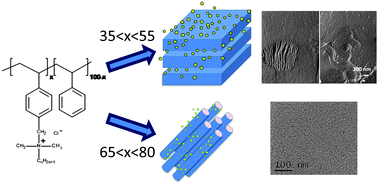One and two dimensional self-assembly of comb-like amphiphilic copolyelectrolytes in aqueous solution†
Abstract
The spontaneous

Maintenance work is planned for Wednesday 1st May 2024 from 9:00am to 11:00am (BST).
During this time, the performance of our website may be affected - searches may run slowly and some pages may be temporarily unavailable. If this happens, please try refreshing your web browser or try waiting two to three minutes before trying again.
We apologise for any inconvenience this might cause and thank you for your patience.
* Corresponding authors
a Physicochimie des Polymères et des Milieux Dispersés, UMR 7615, UPMC-ESPCI-CNRS, 10 rue Vauquelin, 75231 Paris Cedex5, France
b Matière Molle et Chimie, UMR 7167, CNRS-ESPCI Paristech, 10 rue Vauquelin, 75231 Paris Cedex 05, France
c
Rhodia CRTA, 40 rue de la Haie Coq, 93300 Aubervilliers, France
E-mail:
denis.bendejacq@eu.rhodia.com
d
PRES LUNAM, Université du Maine, IMMM UMR CNRS 6283 Département Polymères, Colloïdes, Interfaces, Avenue O. Messiaen, 72085 Le Mans Cedex9, France
E-mail:
christophe.chassenieux@univ-lemans.fr
e U.R. 1268 Biopolymères Interactions Assemblages (BIA), INRA, Rue de la Géraudière, BP71627, 44316 Nantes Cedex 3, France
The spontaneous

 Please wait while we load your content...
Something went wrong. Try again?
Please wait while we load your content...
Something went wrong. Try again?
C. Limouzin-Morel, F. Dutertre, W. Moussa, C. Gaillard, I. Iliopoulos, D. Bendejacq, T. Nicolai and C. Chassenieux, Soft Matter, 2013, 9, 8931 DOI: 10.1039/C3SM51895G
To request permission to reproduce material from this article, please go to the Copyright Clearance Center request page.
If you are an author contributing to an RSC publication, you do not need to request permission provided correct acknowledgement is given.
If you are the author of this article, you do not need to request permission to reproduce figures and diagrams provided correct acknowledgement is given. If you want to reproduce the whole article in a third-party publication (excluding your thesis/dissertation for which permission is not required) please go to the Copyright Clearance Center request page.
Read more about how to correctly acknowledge RSC content.
 Fetching data from CrossRef.
Fetching data from CrossRef.
This may take some time to load.
Loading related content
